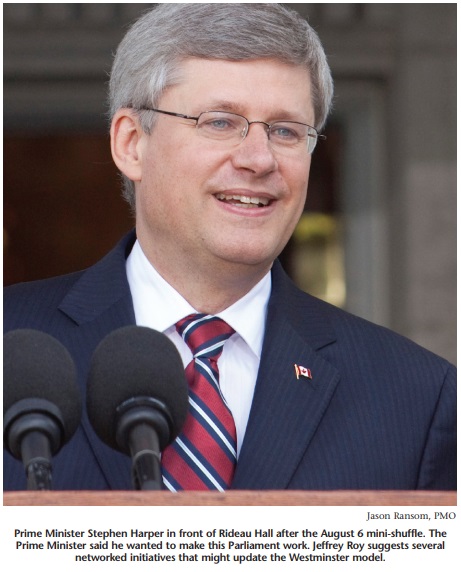
The purpose of this article is to address a fundamental contradiction between today’s policy and service environment and the Westminster model of democratic governance and accountability. Simply put, the former is increasingly shaped by networks of rising complexity and interdependence, whereas the latter functions according to political hierarchy and autonomy. Such a contradiction between collaboration and control only accentuates first minister’s dominance as a necessary reaction (from the Prime Ministers’ Office [PMO] federally or premiers’ offices provincially), weakening performance capacity and legitimacy as a result.
The need for networked or cross-governmental mechanisms for coordination and integrative decision-making is hardly new. Indeed, it lies at the heart of Westminster governance and the role of cabinet, the body initially conceived to house open exchange and ultimately craft a consensus view to be carried forward to Parliament for scrutiny and (ideally) legislative passage. The DNA of cabinet was, therefore, and remains secrecy — in order to enable the formation of a government’s positions and policies in a collective manner.
Yet the formation has become ever less collective, as has been well documented in recent years by the likes of Donald Savoie and others. The apparatus of central agencies, beginning first and foremost with the Prime Minister’s Office, has come to mean that coherence in governmental strategies and agendas requires centralization and control — of the information flows and messaging coming from government on the one hand, and in terms of specific legislative initiatives on the other. In short, the traditional role of cabinet as a deliberative and policy development vehicle has been, to a significant degree, subsumed within the confines of the PMO.
Nonetheless, such centralization does not entirely negate the role of individual ministers. Consider three possibilities. First and foremost, ministers are responsible for overseeing billion-dollar operations within their specific fiefdoms that both implement policies with significant degrees of discretion and deliver critical services to individuals, companies and communities. Second, ministers are answerable, both inside and outside of Parliament, on issues pertaining to their own portfolio, as we have seen recently with Industry Minister Tony Clement and the longform census debate. Third, ministers can still navigate the operational and political channels of central agencies and the PMO to bring new ideas to cabinet for consideration.
In each of these three instances, however, the contradiction presented at the outset of this article — the tension between hierarchy and networks — asserts itself, with growing consequences for both process and performance.
First, in terms of managerial responsibilities of ministers, the rising importance of policy networks and service integration initiatives — both less vertical than horizontal within government (and often outside as well as across government levels and externally with other sectors) — suggests a world where ministers should be overtly collaborating with one another. An obvious example is climate change: a macro issue cutting across various ministries, including most notably Environment, Natural Resources, Industry and Health. Similarly, the formation of Service Canada as the service integrator for the Government of Canada gives rise to questions of the feasibility of a single minister being responsible for such a cross-governmental agent of change.
Perhaps ministers do collaborate in private — but in public they rarely do, and are almost never asked to do so in formally binding mechanisms of one sort or another. In the absence of such visible and formalized ties — which are the basis of more networked governance — the public is left with a stark choice between an individual minister and the prime minister or the interrelated reality that the minister is speaking on behalf of the government under the watchful eye of the PMO. (Under the Conservatives, for example, the communications apparatus has been tightened significantly around not only public servants but ministers themselves.)
Accordingly, on the second point — ministers as answerable spokespersons and proactive agents of change — the scope for speaking freely has steadily diminished due to tighter control from the centre. The result is an erosion of legitimacy in the eyes of the public since the stark choice between a tightly scripted minister and an all-powerful prime minister is hardly in keeping with what the public understands to be, more often than not, a more complicated set of issues and players not easily simplified in such a manner.
The need for networked or cross-governmental mechanisms for coordination and integrative decision-making is hardly new. Indeed, it lies at the heart of Westminster governance and the role of cabinet, the body initially conceived to house open exchange and ultimately craft a consensus view to be carried forward to Parliament for scrutiny and (ideally) legislative passage.
Traditional media, most especially television outlets and reporters, is enormously influential in this regard, contributing to this artificial simplicity and adversarial communications and messaging. All too often, elected officials (ministers or otherwise) are reduced to conveying predetermined speaking points provided by party leaders and their offices — and due to the nature of television itself, this dynamic is increasingly problematic and damaging to the credibility of politics at the national level. (Indeed, it is from here that unfortunate comparisons between federal politics and professional wrestling have arisen: an often staged, confrontational spectacle that attracts a loyal minority but produces disdain or indifference across a wider majority.)
Outgoing Government House Leader Jay Hill recently reflected on his Reform Party roots in pointing out that all political parties face an unavoidable dilemma in this regard: freeing up elected members to speak their minds translates into disorganization and even chaos through the media lens, whereas strong and effective leadership is synonymous with a consistent, unified message. Surely other parties can relate. Yet perhaps nearly 20 years after the rise of Reform, the broader public is ready for something a bit more nuanced — and more consistent with the sorts of leadership patterns they see daily in the workplace and in communities. (And perhaps television journalists and commentators — rivalling politicians in terms of public trust and esteem — will then begin to follow suit.)
The third point — the prerogative of ministers to bring forward ideas and initiatives to cabinet — is perhaps the most under appreciated aspect of governing and ministerial influence, since it is by and large shielded from the public. Despite the main legislative priorities being tightly controlled by the Prime Minister (with a fluctuating bit of leeway for the Finance Minister in budgetary decisions), a multitude of smaller but highly consequential decisions and debates are dealt with by cabinet on a regular basis.
Yet the perception and reality of centralized decision-making on the big policy items, coupled with the mediacentricity of party leaders and the Prime Minister in particular, greatly reduce the scope of innovation that any single minister may possess. Accordingly, ministers both federally and provincially are far less known today as public figures than in decades past, since their influence has waned, and much of the influence they do have is unreported and thus unappreciated. Here again this is a particularly acute problem in Canada federally: witness the strong media interest in former minister Maxime Bernier giving speeches on unorthodox policy ideas in recent times (even as much of the television coverage frames such interventions as about prospective leadership aspirations more than ideas).
What can be done? I have argued elsewhere for the need to broadly rethink the entire Westminster model, since one can reasonably ask whether a system designed in the 19th century is sufficiently robust to meet the challenges of the 21st. Yet let’s give credit where credit is due: Canadian governance remains relatively strong, and in democracy, stability counts a good deal. Accordingly, the purpose here is to propose a set of more modest, incremental reforms that can begin to address the underlying contradiction between control and complexity in innovative ways more conducive to today’s policy and service complexities.
Three broad directions are proposed here: greater openness and usage of cabinet committees; the deployment of interministerial task force mechanisms on integrative agendas; and the formation of openly consultative stakeholder communities themselves created to examine complex and cross-cutting issues.
First, cabinet committees: if Canadians are less aware of who their ministers are, the existence and functioning of cabinet committees remain completely off the radar for most citizens (much as they remain unlisted on the government’s own Web site listing the ministry). Consistent with centralization, the exceptions in terms of committees with something of a public profile are associated with a single personality (the Prime Minister in the case of Priorities and Planning, and the President of the Treasury Board).
Beyond these two bodies there are some sensibly integrative committees such as Economic Growth and Prosperity, Environment and Energy, Social Affairs, and Foreign Affairs and Security, among others. Hidden by the traditions of cabinet secrecy, the strategic deliberations and direction-setting of these groups and others (presuming, optimistically, they have such a role) are shielded from public view.
There is no good reason why these cabinet committees cannot meet in public without compromising the integrity of the cabinet system (select committees such as Priorities and Planning and special meetings of the full ministry could still be closed when truly warranted).
Indeed, there is much value in doing so, to provide a platform for thoughtful and reflective planning and exchange (and one less dominated by the First Minister). While the first few meetings would no doubt resemble a television media circus, with sound bites delivered by cautious participants, a normalization of such events would diminish the sensationalism of such coverage over time (as their purpose would be not to define cabinet’s position but to promote learning and dialogue both inside and outside of government).
The second direction — building on these more openly recognized and influential committees — would be to begin experimenting with interministerial task forces designed to pursue specific (and ideally strategic) policy and service agendas transcending various portfolios. Climate change, public safety and security, service delivery reform and the digital society are examples ripe for greater collaborative and more integrative action.
Importantly, these bodies should be both funded with budgetary resources and evaluated on outcomes in an integrative manner: public reporting would be the key to facilitating such a sorely needed sharing of accountability. While the traditional media would ask who’s in charge, the collective response of task force members would be, “We all are, and we shall be judged accordingly!” In the early days, any political risk in such experimentation would be tempered by a modest investment in resources, although the payoff of greater public interest and appreciation should not be discarded due to the immediate reflexes of mainstream media.
Whereas such integrative bodies should steadfastly avoid assigning “lead” responsibilities to a single member (thereby ensuring centralization by stealth), it may be at times appropriate to foster more integrative organizational mechanisms within the public service, with a senior official (or a group of officials) overseeing the fostering of more networked activity. For example, recent debates surrounding the absence of oversight and coordination in public safety and antiterrorism (not just within this departmental portfolio but across government) have led to calls for the creation of a “czar” to facilitate or ordain (depending on one’s perspective) systemic change. Such a person, or persons, should — in a networked world — be working under direction from and reporting to a group of publicly recognizable ministers explicitly tasked with shared objectives achievable only via integrative means.
Third, the opening up of cabinet committees and the empowerment of interministerial mechanisms should both facilitate and be complemented by the creation of more open and flexible stakeholder communities less partisan in composition and function. Whereas cabinet bodies would remain within the confines of Westminster confidence realities, these less binding and more consultative bodies — requiring some level of multiparty agreement — would leverage the broader participation of elected officials, stakeholders from the private and civic sectors and the citizenry at large.
To remain with the example of public safety and national security, such a forum is sorely needed in helping governments navigate the difficult trade-offs between personal rights and privacy and the collective public interest, and especially tensions between openness and transparency (tensions accentuated in a multicultural environment, as Richard Fadden, head of the Canadian Security Intelligence Service, reminded us in recent months). Broader political oversight and public engagement were key outcomes of the O’Connor Inquiry in the aftermath of the Maher Arar affair, and beyond some important and longoverdue RCMP reforms (still awaiting passage), new tools and channels for public exchange and learning remain by and large absent.
Unlike cabinet and parliamentary committees, which operate in highly formalistic settings, these stakeholder communities could also conduct much of their activity online, both via Parliament-initiated venues and externally, where dialogue is initiated by other groups committed to open and civil exchange. Outside of the direct purview of Parliament, such forums could help lessen — especially through public visibility and engagement — the excessively partisan nature of politics in today’s legislatures.
All three directions, in promoting a more collaborative political ethos, would also enable a more networked public service. At present, horizontal initiatives are no match for ministerial silos. In the case of Service Canada, for example, the Liberals established a cabinet-level committee on government-wide service reform that rarely met and has since disappeared altogether under the Conservatives. In a democracy, political and managerial innovations are closely intertwined.
It is rather telling that at present, the federal cabinet does not include a committee devoted to democratic reform (where these ideas and others could potentially be aired for consideration). Instead, such “reform” under the current government has featured adding MPs and proposing changes (stymied) to the Senate, an uninspiring combination. It is equally telling in this regard that the minister assigned responsibilities for democratic reform is one of two ministers of state listed under the Prime Minister’s domain (thereby personifying the centralized mindset).
The Liberals have proved equally resistant to institutional change: Michael Ignatieff favours better usage of existing parliamentary features to curb prime ministerial power (as all aspirants do, until taking office). How parties behave with one another also matters considerably. As Tom Flanagan writes in this issue of Policy Options, a little power-sharing would go a long way: recent examples such as refugee reforms and the Afghan documents agreement suggest that party collaboration, though exceptionally rare at present, need not be entirely elusive.
While these three directions may or may not be enough to salvage the Westminster system of representative democracy and accountability in an era of relentless openness and an ever more informed (though not necessarily engaged) citizenry, they would at least give our present model a fighting chance for incremental improvement. There is widespread acceptance today that good governance must be flexible, adaptive and collaborative — coexisting at times with the need for clarity and control. It is imperative that our public institutions break free from the confines of tradition and begin overtly grappling with this otherwise elusive balance.
Photo: Shutterstock








